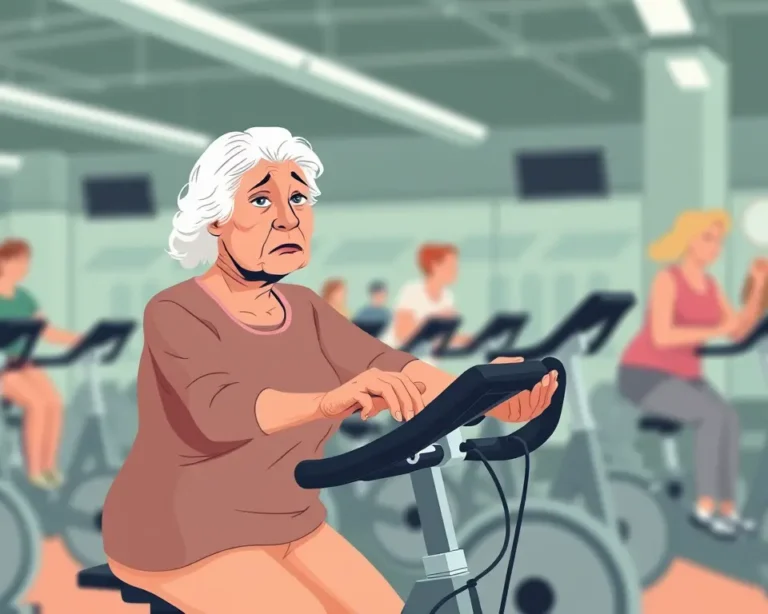Staying active is crucial as we age, but not all exercises are created equal. Fitness experts are increasingly cautioning individuals over 50 to carefully evaluate their workout routines, suggesting that certain exercises, even those seemingly benign, could pose a risk to joint health, spinal integrity, and overall well-being. This isn’t about giving up on fitness; it’s about making informed choices to ensure a safe and effective exercise regimen for the long haul.
Why Exercise Needs Change After 50
As we enter our sixth decade and beyond, our bodies undergo significant changes. Bone density naturally decreases, increasing the risk of fractures. Joint flexibility diminishes, making us more susceptible to strains and sprains. Muscle mass also declines, impacting strength and balance. These age-related changes don’t mean we should stop exercising; on the contrary, regular physical activity becomes even more vital for maintaining independence and quality of life. However, it does mean we need to adjust our approach.
High-Impact Cardio: Proceed with Caution
Cardiovascular exercise is essential for heart health, but high-impact activities like running on hard surfaces, jumping jacks, and intense aerobics classes can be hard on aging joints. The repetitive pounding can exacerbate existing conditions like arthritis and lead to new injuries in the knees, ankles, and hips.
Safer Alternatives
- Walking: A simple yet effective way to elevate your heart rate without stressing your joints. Consider brisk walking, Nordic walking (using poles for added upper body engagement), or hiking on gentle trails.
- Swimming: Water provides buoyancy, minimizing impact on joints while providing a full-body workout.
- Cycling: Whether outdoors or on a stationary bike, cycling is a low-impact cardio option that strengthens leg muscles and improves cardiovascular fitness.
- Elliptical Training: Offers a similar cardiovascular workout to running but with significantly reduced impact.
Weightlifting: Finding the Right Balance
Strength training is crucial for maintaining muscle mass and bone density, but lifting excessively heavy weights without proper form can be risky for older adults. It can strain muscles, ligaments, and joints, leading to injuries such as strains or even tears.
Key Considerations
- Focus on Form: Prioritize proper technique over the amount of weight lifted. If you’re unsure about your form, consult with a qualified personal trainer.
- Lighter Weights, Higher Repetitions: Use lighter weights and focus on performing more repetitions with good form. This approach builds muscle endurance and strength without putting excessive stress on your joints.
- Resistance Bands: A versatile and effective alternative to traditional weights, resistance bands provide a progressive challenge while minimizing joint stress.
- Listen to Your Body: Pay attention to any pain or discomfort and stop immediately if you experience it.
Deep Squats: Know Your Limits
Squats are an excellent exercise for lower body strength, but deep squats (those that go beyond a 90-degree angle at the knee) can put excessive strain on the knees and lower back. As we age, joint flexibility tends to decrease, making deep squats potentially harmful.
Modified Approach
- Limited Range of Motion: Perform squats with a limited range of motion, stopping when your thighs are parallel to the ground.
- Supported Squats: Use a chair or wall for support to maintain balance and control the movement.
- Alternative Exercises: Consider leg presses or lunges, which offer similar benefits with less risk.
Overhead Exercises: Shoulder with Caution
Exercises that involve lifting weights overhead, such as military presses or overhead tricep extensions, can put excessive strain on the shoulder joint, especially if you have pre-existing shoulder issues.
Safer Options
- Front Raises: Lift weights in front of you to shoulder height, engaging the shoulder muscles without excessive overhead strain.
- Lateral Raises: Lift weights out to the sides to shoulder height, targeting the deltoid muscles.
- Rows: Pull weights towards your chest, working the back and shoulder muscles without overhead movement.
- Consult a Professional: Before attempting any overhead exercises, consult with a physical therapist or certified trainer to assess your shoulder health and range of motion.
Risky Spinal Twists: Protect Your Back
Certain spinal twists, especially those performed aggressively or without proper control, can put excessive pressure on the spine and potentially lead to strains, herniated discs, or other spinal injuries.
Gentle Alternatives
- Seated Twists: Perform gentle seated twists, keeping your back straight and twisting from your torso.
- Standing Twists: Stand with your feet shoulder-width apart and gently twist from side to side, keeping your movements controlled.
- Cat-Cow Pose: A gentle yoga pose that improves spinal mobility and flexibility.
- Avoid End-Range Twisting: Avoid twisting too far or forcing the movement. Listen to your body and stop if you feel any pain.
Plyometric Exercises: Think Before You Leap
Plyometric exercises, also known as “jump training,” involve explosive movements like box jumps or depth jumps. These exercises can place significant stress on the ankles, knees, and hips, particularly if your joints aren’t prepared for the impact.
Considerations
- Assess Joint Health: Before attempting plyometric exercises, assess your joint health and stability. If you have any existing joint issues, avoid these exercises altogether.
- Start Gradually: If you’re new to plyometrics, start with low-impact variations and gradually increase the intensity as your body adapts.
- Proper Landing Technique: Focus on landing softly with bent knees to absorb the impact.
- Alternative Exercises: Consider lower-impact exercises like step-ups or walking lunges, which provide similar benefits without the high impact.
Behind-the-Neck Pull-Downs and Pull-Ups: A Shoulder Impingement Risk
Pulling a bar behind your neck during pull-downs or pull-ups can place excessive strain on your shoulders and increase the risk of rotator cuff injuries.
Safer Variations
- Front Pull-Downs: Pull the bar down to your chest, keeping your elbows slightly forward.
- Assisted Pull-Ups: Use an assisted pull-up machine to reduce the amount of weight you’re lifting.
- Rows: Perform rows with a barbell, dumbbells, or resistance bands to strengthen your back and biceps without putting excessive stress on your shoulders.
Leg Extension Machines: Isolate and Potentially Injure
While leg extension machines can isolate the quadriceps muscles, they can also put undue stress on the knee joint, especially if you have existing knee problems.
Functional Alternatives
- Squats: Engage multiple muscle groups in your lower body, including the quadriceps, hamstrings, and glutes, while promoting functional strength and stability.
- Lunges: Another excellent exercise that works the quadriceps, hamstrings, and glutes while improving balance and coordination.
- Step-Ups: A versatile exercise that can be modified to increase or decrease the intensity, step-ups strengthen the lower body and improve balance.
Crunches: Core Without Compromise
Traditional crunches can put pressure on the spine and may not be the most effective way to strengthen your core.
Core-Engaging Alternatives
- Plank: Engages your entire core, improving stability and posture without putting stress on your spine.
- Bird Dog: Improves core stability and coordination while strengthening the back muscles.
- Dead Bug: A gentle yet effective exercise that strengthens the core and improves coordination.
The Importance of Individualization and Professional Guidance
It’s crucial to remember that everyone’s body is different, and what works for one person may not work for another. Before starting any new exercise program, it’s essential to consult with a healthcare professional or a qualified fitness expert. They can assess your individual needs, limitations, and goals, and help you develop a safe and effective exercise plan. A physical therapist can identify any underlying musculoskeletal issues and provide guidance on proper form and technique. A certified personal trainer can design a personalized workout program that takes into account your specific needs and goals.
Listen to Your Body
Above all, it’s essential to listen to your body and pay attention to any pain or discomfort you may experience during exercise. Don’t push yourself too hard, and don’t be afraid to modify exercises or take breaks when needed. Exercise should be enjoyable and empowering, not painful or debilitating. By making informed choices and prioritizing safety, you can continue to enjoy the benefits of physical activity well into your 50s and beyond.







